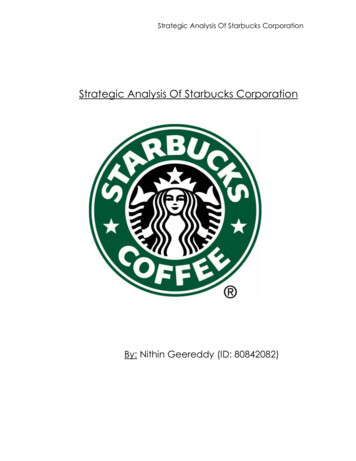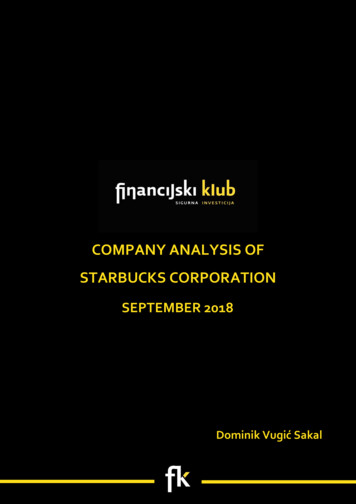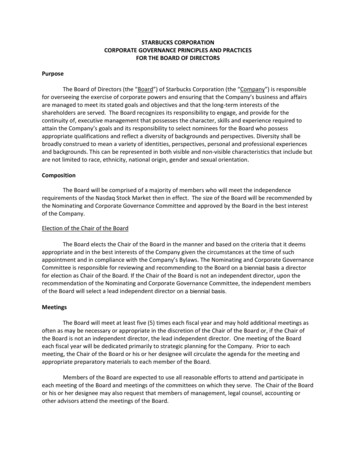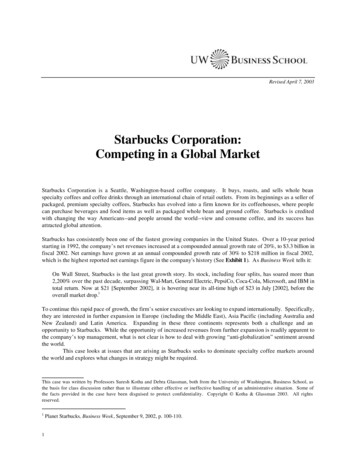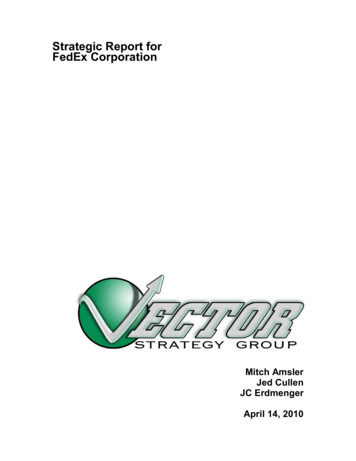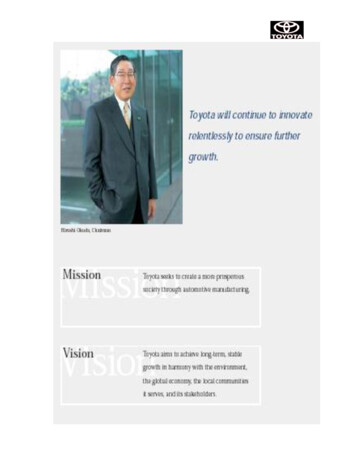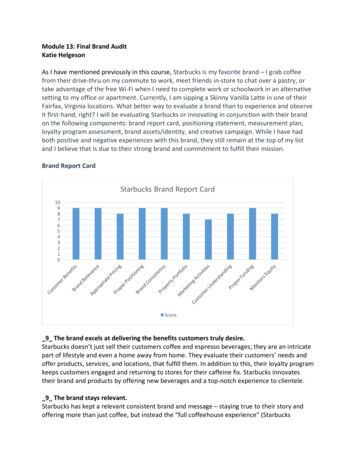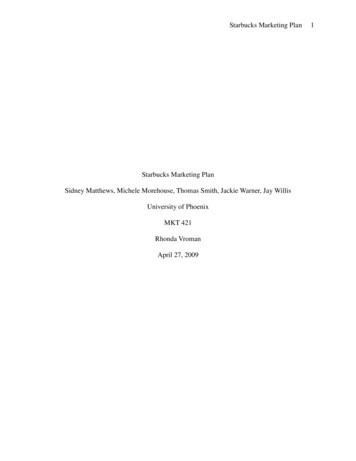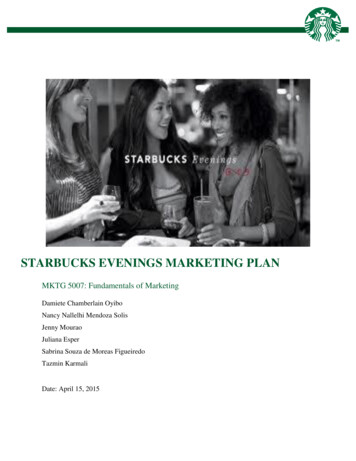
Transcription
Strategic Report forStarbucks CorporationHarkness ConsultingInnovation through CollaborationHarry LeshnerCathryn CamachoScott Damassa
Table of ContentsApril 14, 2007Executive Summary .2Company History . .3Competitive Analysis 5Internal Rivalry 5Entry 8Substitutes and Complements 9Supplier Power 10Buyer Power 11SWOT Analysis . 11Financial Analysis . .12Strategic Issues and Recommendations . .17Appendix 20References . 23Harkness Consulting1
Executive SummaryStarbucks Corporation, formed in 1985, is a leading specialty coffee retailer and one of the bestknown brands today i . In addition to its sale of high‐quality coffees, Starbucks retail stores alsooffer Italian‐style espresso beverages, cold blended beverages, complementary food items,coffee‐related accessories and equipment, premium teas, and a line of compact discs. Outside ofits company‐operated retail stores, Starbucks also sells packaged coffee and tea products, ready‐to‐drink beverages including its bottled Frappuccino beverages and Starbucks DoubleShot espresso drinks, ice creams, and other products mainly through licensing relationships. Thecompany’s brand portfolio includes Tazo teas, Starbucks Hear Music compact discs, Seattle’sBest Coffee , and Torrefazione Italia coffee.Throughout its history, Starbucks has been known for its aggressive store expansion, as itseemed impossible to open new stores quickly enough to keep up with demand. However,since its stock falling from about 80 per share near the end of 2006 to its current price of about 18 per share ii , along with a dramatic decline in the growth of its same‐store sales last quarter iii ,it seems that Starbucks may have run out of growth opportunities. Furthermore, as otherspecialty coffee retailers such as Peet’s Coffee and Tea and Caribou Coffee have entered themarket, and as competition from fast food chains such as Dunkin’ Donuts and McDonald’s hasincreased, Starbucks has lost market share. Therefore, it may appear that the company is indecline.Despite these conditions, Starbucks remains the strongest company in the industry and it hasmany opportunities to increase its profits.The major issues facing the company includemaintaining the Starbucks Experience for customers, store expansion and real estate issues,competition from fast‐food chains and other specialty coffee retailers, specialty operations,generating more demand and penetrating new markets, and lowering input costs. Since thereturn of Howard Schultz in January 2008, much has been done that addresses the first threeissues mentioned. The analysis in this report will help reaffirm those initiatives as well asdiscover others that address the last three issues and will enhance the company’s performance.Harkness Consulting2
Starbucks must seek more licensing relationships that will increase revenues from specialtyoperations at little cost, and also expose the brand. Existing retail stores must attract morecustomers and increase sales, especially after the morning rush hours, and can do so byexpanding non‐coffee beverage options. Finally, the company will drastically reduce its inputcosts by abandoning purchases of Fair Trade CertifiedTM coffee, which can be accomplishedwithout drawing negative attention to the brand.Company HistoryStarbucks began as a whole bean coffee seller in Seattle, Washington at Pikes Place in 1971 iv .The original location’s name was “Starbucks Coffee, Tea, and Spices,” This caused someconfusion and was later shortened to the “Starbucks Coffee Company.” The name Starbuckscomes from the first mate in the Moby Dick book by Herman Melville. Since its inception, thecompany’s goal has been to find the premier coffee in the world and present it to people whowould otherwise not be exposed to it.In 1982 Starbucks acquired the services of Howard Schultz as the director of retail operationsand marketing and the company began to expand its businesses by providing coffee to finerestaurants and espresso bars v . Starbucks put an emphasis on freshness during this time andwould replace coffee it deemed not to be fresh, and thus unfit for consumption, for free so thatcustomers received only the best coffee at these restaurants. A major shift in the Starbucksbusiness plan occurred in 1983 when Schultz traveled to Italy and noticed the popularity ofespresso bars in Milan. This gave him the idea that this would work in the United States, andStarbucks began testing this concept in 1985, successfully.In 1985, Schultz founded Il Giornale vi , which offered brewed Starbucks products in his Milanespresso bar replicas. Il Giornale succeeded and in 1987 Schultz secured the backing of localinvestors and acquired Starbucks Assets and changed the name to “Starbucks Corporation”.From 1987 to 1992 Starbucks Corporation grew to 165 locations. This also included a mail orderHarkness Consulting3
catalog, a new headquarters, airport locations, and deals with several airlines to serve coffee onboard.On June 26th, 1992 Starbucks IPO’d at a price of 17 per share and closed trading on the first dayat 21.50 per share vii . SBUX common stock is traded on the Nasdaq exchange. Since then,Starbucks has been one of the leaders in stock incentive programs involving even its part‐timebaristas. Starbucks was one of the first and still the most active companies in granting stockoptions to its entry‐level employees regardless of salary.This is one of the reasons thatStarbucks has been able to have such a high level of service over the years, because itsemployees care about the public perception of the company.From 1992 to 2000 the Starbucks Corporation continued to grow and flourish by increasing itsstore total to an astounding 3,501 stores. During this time the company acquired Tazo teas &Hear Music in 1999, in hopes that people would view Starbucks as a destination, instead ofsimply a coffee shop viii . Starbucks has continued to acquire companies in order to make thetransformation from simple coffee bar to entertainment destination by offering high speedinternet since 2001, and starting events for local artists and musicians in the recent years.Throughout the years Starbucks has grown its core business away from just coffee to adiversified portfolio including many different goods. The company’s current product portfolioincludes ix : Over 30 blends and single‐origin coffees Unlimited combinations of brewed coffee and tea products Fresh foods; which includes pastries, sandwiches & salads Music, books, and film Packaged drinks and Starbucks liqueurs The Starbucks Card ( 2.5 Billion in activations and reloads since 2001)Harkness Consulting4
In addition to its extensive product offerings, the Starbucks Corporation has many brandswhich it cultivates including; Starbucks Entertainment, Starbucks Hear Music , Tazo Tea,Ethos Water, Seattle’s Best Coffee , and Torrefazione Italia coffee.The successfulmanagement of all of these brands pulled together represents the Starbucks portfolio in mostStarbucks locations.Aside from products and brands, Starbucks is one of the most globally conscious corporationsin America. In 2006 Starbucks donated 36.1 million in cash and products, volunteered 383,000hours in local communities, required growers to use strict environmental guidelines, used 20%renewable energy in stores, and actively recycled in almost 80% of stores in US and Canada x .Starbucks has established itself as the coffee leader in the world and has done so on a sociallyand environmentally conscious platform. Throughout the years, the company has been theindustry leader in promoting conservation in its actions and its preaching to the rest of theworld. During this time, the company has surpassed all competition in this market because ofits quality products and its focus on service. Starbucks has created a system of business whereeven the lowest paid employee is still encouraged to take pride in the company for which heworks because it is tied to his compensation, which has helped to infiltrate the missionstatement of Starbucks into all levels of employees.Competitive AnalysisPorter’s Five Forces Summary for StarbucksActing ForceInternal RivalryEntrySubstitutes and ComplementsSupplier PowerBuyer PowerLevel of Threat to ProfitsMidLow‐midMidLowLowInternal RivalryAs the specialty beverage industry only grows more competitive, Starbucks’ dominantpositioning with a large market share is continuously under pressure. Since its inception,Harkness Consulting5
Starbucks has stimulated the overall market, creating a positive spillover effect that increasedthe demand for quality coffee beverages.Therefore, even though Starbucks has rapidlyexpanded, so have local coffeehouses and ‘mom‐and‐pop’ stores. Thus, elasticity has increasedwith the variety of substitutes available to consumers offering the same product: premiumcoffee, friendly staff, and a comfortable milieu. For this reason, recent trends indicate industrystagnation within the domestic market as coffeehouses are now ubiquitous. Though the trendhas peaked domestically, coffee and coffeehouses are still ingrained in the American cultureleaving this market profitable.Fragmented rivalry is due to the nature of the industry, which is split between national,regional, and local competitors domestically and abroad.Within the U.S., key nationalcompetitors include Dunkin’ Donuts, McDonalds, and other fast food chains sprucing up anddiversifying their beverage menu. However, the targeted customer base differs as Starbuckscaters to high‐end customers with its gourmet drinks. Nonetheless, the Starbucks Corporationmust be conscious of its price point, so as not to exclude too many potential patrons. Regionally,the industry may be divided as follows among top rivals:West coast: Coffee Bean & Tea Leaf and Peet’s Coffee and TeaMidwest: Caribou Coffee and PaneraEast coast: Tim HortonsThese companies are better direct competitors to Starbucks than the national fast food chains asthey appeal to the same consumer base and offer similar product selections. Caribou Coffee isthe second largest corporation within the domestic specialty beverage industry. However, as ofSeptember 30, 2007 Starbucks operated 6,793 stores domestically and 1,712 stores internationallywhile Caribou Coffee operated 447 stores domestically and 17 internationally xi . Lastly, localcompetitors such as site‐specific proprietorships and ‘mom‐and‐pop’ coffeehouses vie withStarbucks as well. While they are not threats to general empire Starbucks has created, they doreduce profit margins as they appeal to many coffee drinkers with their more personalcharacter. These smaller proprietorships are Starbucks’ greatest competitor abroad, which isHarkness Consulting6
why recent expansion plans have focused on capturing international markets. Clearly, there area large number of rivals within the specialty beverage industry creating a rather competitivelandscape.Customers do not incur a monetary switching cost in the specialty beverage industry;nonetheless, an emotional attachment to image and reputation keep them loyal to certain brandnames.Even though only a superficial difference exists between coffeehouses, firmsdifferentiate their products to capture customers from rival brands. The Starbucks name hasacquired a significant status and has ranked as one of the most influential brand names in theAmerican culture. With its well‐trained baristas, comfortable atmosphere, and quick service,Starbucks has incorporated important characteristics appealing to customers. In the Starbucksbusiness model, customers are more important than product. However, even though Starbucksis able to sell its goods at a higher price point, it must be conscious of the elastic market. Forexample, after increases in dairy costs –an input good every coffeehouse model– Starbucksstores felt the need to announce the reason for price increases so as not to shock customers. Thecompany informed its customers of the pricing discrepancy because it did not want to lose theirfuture patronage due to the economic circumstances at the time. This example illustrates thepoint that even though Starbucks has brand name loyalty, the company is still susceptible to theelastic nature of the market.Starbucks is able to remain competitive within the market due to its sheer size and businessmodel. As Starbucks takes advantage of economies of scale and scope, it follows a different coststructure than other corporations in the market. First, Starbucks pays less for the products it isable to buy in bulk such as dairy goods, syrups, paper goods, etc xii . For this reason, thecompany reaps higher margins with its specialty drinks, which also help differentiate itself fromother coffeehouses. As customers know they can customize their drinks and the quality of thedrink is guaranteed based upon reputation, Starbucks is always in their evoke set. Next, as nocooperative pricing exists in this industry, Starbucks prices its drinks based upon the elasticityof its target customer. Appealing to conspicuous consumption, Starbucks prices are higher thanHarkness Consulting7
its competitors, lending toward its high trend status. Last, Starbucks is able to differentiateitself due to its commitment to reduce its environmental impact. Again, its size enables thecompany to seek, incorporate and market these environmentally friendly endeavors.Forexample, the company replaced cups and cup sleeves with ones that used post‐consumerrecycled materials xiii . Also, Starbucks adheres to purchasing guidelines, The Commitment toOrigins, which promote economic transparency in not only buying the best coffee, but also atpremium prices to help farmers. These practices further differentiate
Starbucks is able to remain competitive within the market due to its sheer size and business model. As Starbucks takes advantage of economies of scale and scope, it follows a different cost structure than other corporations in the market. First, Starbucks pays less for the products it is
